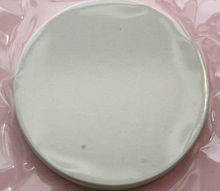
Back Bariumtitanaat Afrikaans تيتانات الباريوم Arabic تیتانات باریوم AZB Бариев титанат Bulgarian Triòxid de bari i titani Catalan Bariumtitanat German Titanato de bario Spanish تیتانات باریم Persian Bariumtitanaatti Finnish Titanate de baryum French
 Polycrystalline BaTiO3 in plastic
| |
| Identifiers | |
|---|---|
3D model (JSmol)
|
|
| ChemSpider | |
| ECHA InfoCard | 100.031.783 |
| EC Number |
|
PubChem CID
|
|
| RTECS number |
|
| UNII | |
CompTox Dashboard (EPA)
|
|
| |
| |
| Properties | |
| BaTiO3 | |
| Molar mass | 233.192 g/mol |
| Appearance | White crystals |
| Odor | Odorless |
| Density | 6.02 g/cm3, solid |
| Melting point | 1,625 °C (2,957 °F; 1,898 K) |
| Insoluble | |
| Solubility | Slightly soluble in dilute mineral acids; dissolves in concentrated hydrofluoric acid |
| Band gap | 3.2 eV (300 K, single crystal)[1] |
Refractive index (nD)
|
no = 2.412; ne = 2.360[2] |
| Structure | |
| Tetragonal, tP5 | |
| P4mm, No. 99 | |
| Hazards | |
| GHS labelling: | |

| |
| Warning | |
| H302, H332 | |
Except where otherwise noted, data are given for materials in their standard state (at 25 °C [77 °F], 100 kPa).
| |
Barium titanate (BTO) is an inorganic compound with chemical formula BaTiO3. Barium titanate appears white as a powder and is transparent when prepared as large crystals. It is a ferroelectric, pyroelectric, and piezoelectric ceramic material that exhibits the photorefractive effect. It is used in capacitors, electromechanical transducers and nonlinear optics.
- ^ Suzuki, Keigo; Kijima, Kazunori (2005). "Optical Band Gap of Barium Titanate Nanoparticles Prepared by RF-plasma Chemical Vapor Deposition". Jpn. J. Appl. Phys. 44 (4A): 2081–2082. Bibcode:2005JaJAP..44.2081S. doi:10.1143/JJAP.44.2081. S2CID 122166759.
- ^ Tong, Xingcun Colin (2013). Advanced Materials for Integrated Optical Waveguides. Springer Science & Business Media. p. 357. ISBN 978-3-319-01550-7.